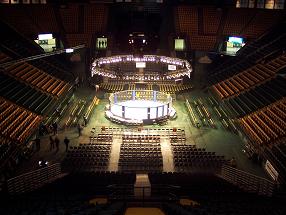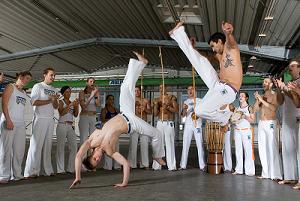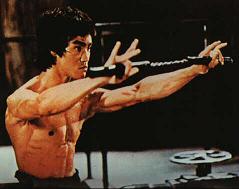|
|
|
|
|
|
|
 |
TO MOST
PEOPLE the continents of North and
South America are not immediately associated with the martial arts.On closer
inspection, however the region reveals iteself as a cultural melting pot in
which vibrant, indigenous, tribal fighting methods stand side-by-side with
martial arts traditions from Europe and Asia. Central and North America's
most popular martial arts are hybrid systems that have emerged through the
continual evolution and amalgamation of indigenous and imported systems. |
 |
|
MARTIAL ARTS have become an
increasingly essential part of the fabric of modern, urban society in many
corners of North, Central, and South America. This has been encouraged by
the demands of live TV broadcasts that have turned some arts into sports
watched by millions—for example, the spectacular Mixed-Martial-Arts
(MMA) competitions of the Ultimate Fighting Championships
(UFC). Movies, too, have
popularized other arts among younger generations eager to learn self-defense
techniques or to imitate their screen heroes. |
 |
 |
 |
|
The African
Connection
The early martial arts of the Americas emerged among the communities of
African slaves who brought their fighting and dancing skills to Brazil and
the Caribbean. They created martial arts such as capoeira , which involves a
multitude of powerful punches, kicks, and head butts.
Capoeira was outlawed,
but the slaves continued to practice their art under the guise of music and
dance performances—the blows were disguised among hypnotic dance movements.
Slave communities also created mani stick fighting in Cuba and calinda in
the Caribbean and New Orleans, and these were also fought with a musical
accompaniment, often at festivals and carnivals. The no-holds-barred
wrestling matches of Brazilian vale tudo and Brazilian jujutsu are
forerunners of mixed martial arts, which saw a huge surge in popularity in
the early 1990s. All these systems have left an indelible imprint on the
martial-arts landscape in the Americas. |
 |
 |
A fusion of styles
Perhaps the best example of the hybrid influences that
distinguish a truly American martial art is Jeet
Kune Do. The legendary martial-arts movie star
Bruce Lee, who was born in San Francisco
and raised in Hong Kong, developed this system from techniques of Chinese
wing chun, Japanese judo, Western boxing, European fencing, and Filipino
arts. Lee drew on philosophies from around the world to express his
thinking. His innovative martial-arts training program was modern and
scientific and emphasized the practical value of nonclassical and
traditional routines. The US culture of freedom, creativity, and a can-do
attitude no doubt played a large part in shaping his thinking. Lee’s legacy
also includes a number of hugely successful movies, almost all of which
highlight his exceptional physical conditioning and martial-arts prowess. |
|
Burgeoning success
The proud martial tradition in America extends from collegiate wrestling,
which is largely based on catch wrestling from Europe, to the
kickboxing
phenomena of the 1970s and 80s that transformed the public perception of
martial arts. Other examples include lua, a unique and exotic combat art
from Hawaii, and American kempo, which is based on Chinese fighting methods
but has a purely English-language syllabus, is taught in an American
cultural context, and was popular with celebrities such as Elvis Presley.
The success of martial arts in the Americas has extended to the military,
security services, and police, all of whom have recognized the benefits of
martial techniques in their field of work. The US armed forces have
extensively researched and developed a number of noteworthy combat systems.
For example, two highly codified, close-quarter combat systems—the
Marine
Corps Martial Arts Program and the LINE system—are specifically designed for
teaching recruits in a limited time-frame and to maximum effect.
|
|
|
|
|













